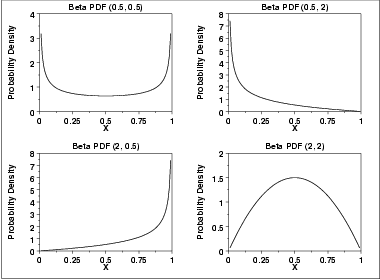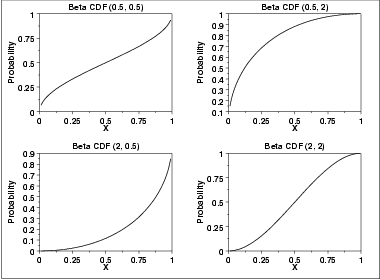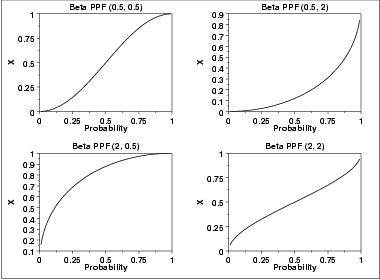
| 1. Exploratory Data Analysis 1.3. EDA Techniques 1.3.6. Probability Distributions 1.3.6.6. Gallery of Distributions
| |||||||||||||
| Probability Density Function | The general formula for the probability density function of the beta distribution is where p and q are the shape parameters, a and b are the lower and upper bounds, respectively, of the distribution, and B(p,q) is the beta function. The beta function has the formula The case where a = 0 and b = 1 is called the standard beta distribution. The equation for the standard beta distribution is Typically we define the general form of a distribution in terms of location and scale parameters. The beta is different in that we define the general distribution in terms of the lower and upper bounds. However, the location and scale parameters can be defined in terms of the lower and upper limits as follows:
scale = b - a The following is the plot of the beta probability density function for four different values of the shape parameters.
| ||||||||||||
| Cumulative Distribution Function | The formula for the cumulative distribution function of the beta distribution is also called the incomplete beta function ratio (commonly denoted by Ix) and is defined as The following is the plot of the beta cumulative distribution function with the same values of the shape parameters as the pdf plots above.
| ||||||||||||
| Percent Point Function | The formula for the percent point function of the beta distribution does not exist in a simple closed form. It is computed numerically. The following is the plot of the beta percent point function with the same values of the shape parameters as the pdf plots above.
| ||||||||||||
| Other Probability Functions | Since the beta distribution is not typically used for reliability applications, we omit the formulas and plots for the hazard, cumulative hazard, survival, and inverse survival probability functions. | ||||||||||||
| Common Statistics | The formulas below are for the case where the lower limit is zero and the upper limit is one.
| ||||||||||||
| Parameter Estimation | First consider the case where a and b are assumed to be known. For this case, the method of moments estimates are For the case when a and b are known, the maximum likelihood estimates can be obtained by solving the following set of equations | ||||||||||||
| Software | Most general purpose statistical software programs support at least some of the probability functions for the beta distribution. | ||||||||||||




